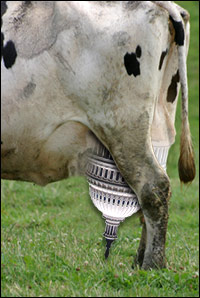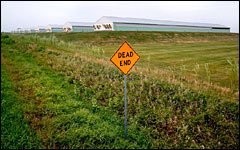Over the past few years, grassroots support has swelled for new federal farm policies — ones that promote healthy, sustainably grown food, not the interests of a few agribusiness firms.

Udder madness.
Photo: iStockphoto
The target of much of this organizing has been the 2007 farm bill. If past farm bill debates have been the concern of a small cadre of lobbyists and activists, this one has hit the mainstream. Informed farm bill discussions have turned up in newspapers’ food sections, general-interest magazines, and even the best-seller list, in the form of books like Michael Pollan’s The Omnivore’s Dilemma and Barbara Kingsolver’s Animal, Vegetable, Miracle. Local chapters of groups like Slow Food have rallied around the cause, and thousands of emails urging reform have stuffed legislators’ inboxes.
In a sense, all of that ink spilled (including gallons of virtual ink right here on Grist), all that effort, all of that hope for new policies has come to naught. Last week, the House passed a farm bill that essentially preserves the worst features of federal agriculture policies since the 1970s, while for good measure gutting the Conservation Security Program*, widely considered a model of prudent farm policy.
In the Senate, agriculture committee chair Tom Harkin (D-Iowa) will mount a valiant defense of the CSP, but won’t likely do much to improve the rest of the bill. The Bush administration, for its part, has threatened to veto the House version, but don’t get your hopes up. Its own agenda is hardly progressive.
Honestly, I can’t say I’m surprised. Since the early 1970s, federal policy has amounted to a disastrous compromise between agribusiness giants, who thrive on steady overproduction of a few commodities like corn and soybeans, and large-scale farm operators in the Midwest. Those groups have enough excess cash for campaign contributions, and political sway in key heartland states, to keep federal farm policy working in their interests.
But if the effort to create a more benign farm bill has proved a crashing failure, that surely doesn’t mean we have to lie down and let the Archer Daniels Midlands and Smithfield Foods of the world run our food system.
What’s Happening in Woodbury County
In short, while federal policy is of course critically important, the fast-and-dirty way to effect food-system change is at the local level. And all over the country, people are doing just that. While these efforts are by nature fragmentary and piecemeal, together they form a kind of policy laboratory from which a blueprint for real reform can emerge.

Industrial pork production in Iowa.
Photo: Mark Hirsch
I spent last week traveling in Iowa, the epicenter of industrial agriculture. Iowa leads the nation in production of corn, soy, pork, and eggs. Nearly 90 percent of the state’s land is under cultivation — almost all of it using environmentally ruinous techniques.
Yet all over the state, citizen-based initiatives are challenging that order. The most inspiring one I saw was in Woodbury County, in the state’s northwest corner. Like most of Iowa, Woodbury has seen a steady decline in small- and mid-sized diversified farms over the past several decades, their land swallowed up by giant operations content to grow mass quantities of corn and soy for industry. Smithfield, ADM, Tyson, and other agribusiness giants operate plants within the county, transforming that dubious bounty into profits for their shareholders — and into processed food (and, increasingly, fuel) of questionable quality destined for different markets.
Yet citizens of that county aren’t waiting for the federal government to reform the policy framework that underwrites these trends. They’re organizing to create alternative food-production networks designed to promote diversified farming and fresh, sustainably grown food.
The county’s local food-production and distribution infrastructure has essentially been dismantled over the past few decades, so Woodbury food activists have worked hard to begin recreating it. Raising hundreds of thousands of dollars in grants, they’ve created an extraordinary institution called the Floyd Boulevard Local Foods Market in downtown Sioux City. The complex includes a natural-foods store open daily, which offers locally produced free-range meat; a weekly farmers’ market featuring vegetables; and a full-service restaurant that sources everything it can from within a 100-mile radius. (I blogged about that wonderful restaurant on Gristmill this week.) The Floyd Boulevard folks also operate a farmer-owned cooperative that sells produce to other nearby institutions and retailers.
Meanwhile, a maverick county official named Rob Marqusee has been busily tweaking county policy to keep mid-sized farmers in business. A few years ago, Marqusee talked county officials into creating a new position called “director of rural economic development” — a revolutionary title in an area where “economic development” usually means begging a company like Smithfield Foods to open a new industrial meatpacking plant.
Marqusee sees it as his job to create an atmosphere where people can make a living through sustainable farming.
“My only budget is my own salary,” he told me — but that hasn’t slowed him down much. Last year, he instituted an “Organics Conversion Policy,” offering up to $50,000 annually in property-tax rebates for farmers who convert from conventional to organic farming practices. And he also made Woodbury the first U.S. county to mandate the purchase of locally grown, organic food. Woodbury’s “Local Food Purchase Policy” requires Woodbury County departments to purchase organic food from within a 100-mile radius for regular city use. Marqusee says the policy has potential to buy as much as $280,000 annually from the Floyd Market farmers’ cooperative.
Even with all of these initiatives, Woodbury County is hardly a local-foods paradise. In a city surrounded by hundreds of thousands of acres of some of the world’s richest farmland, the Floyd Boulevard Market has so far drawn only a dozen or so vendors, as skeptical farmers wait for proof that real money can be made growing food for people nearby to eat.
Industrial ag marches on in Woodbury. The presence of a Smithfield hot-dog plant in downtown Sioux City, which steadily spews foul-smelling smoke into the air, makes its presence palpable. But because of direct citizen action and policy support at the county level, the seeds for fundamental change are planted.
As Pat Garrity, general manager of the Floyd Boulevard market, told me, “If we can make local food work in Iowa, we can make it work anywhere.”
Similar things are happening all across the country; here’s a resource for finding local-food initiatives in your area.
*[Correction, 02 Aug 2007: This article originally stated that the farm bill gutted the Conservation Reserve Program (CRP). In fact, it was the Conservation Security Program (CSP).]

